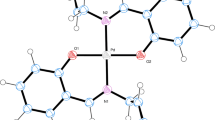Abstract
The Periodic Table has the column of the noble gas atoms (He, Ne, Ar, Kr, Xe, Rn) as one of its main pillars. Indeed the inert chemical nature of their closed shell structure is so striking that it is sometimes extended to all such structures. Is it true however that any closed shell, say a closed d-subshell will denote a lack of chemical activity? Take the noble metals for instance, so renowned for their catalytic capacity. Platinum has 10 electrons in its valence shell which makes one of its excited states to be a closed 5d10–6s0 state. Surely this state would not be expected to be crucial to the catalytic activity of platinum, or would it? Or take palladium whose ground state is precisely the 4d10–5s0 state, should we expect that an isolated Pd atom at near zero-point temperature would attack a closed-shell hydrogen molecule efficiently? We shall here show that this is precisely the case; the closed-shell excited states of nickel and platinum are indeed crucial, through symmetry avoided crossings, for their reactivity. Other valuable catalysts as ruthenium depend on their excited states with maximal d-shell occupancy for their activity. The most notable confirmation of this new finding; that closed d-shells are vital to the catalytic activity of noble metals however, is the case of palladium whose closed-shell ground state is indeed capable of attacking hydrogen and hydrocarbon molecules even at temperatures well below 10 K as was predicted theoretically and immediately confirmed experimentally.
Similar content being viewed by others
References
L. Andrews X. Wang L. Manceron (2001) J. Chem. Phys. 114 1559
K. Balasubramanian Z.K. Wang (1989) J. Chem. Phys. 91 7761
J.C. Barthelat P. Durand A. Serafini (1977) Mol. Phys. 33 159
M.R.A. Blomberg P.E.M. Siegbahn (1986) J. Chem. Phys. 90 1942
U.B. Brandemark M.R.A. Blomberg L.G.M. Peterson P.E.M. Siegbahn (1984) J. Phys. Chem. 88 4617 Occurrence Handle10.1021/j150664a035
J.V. Burda N. Runeberg P. Pikko (1998) Chem. Phys. Lett. 238 635
S. Castillo E. Poulain O. Novaro (1991) Int. J. Quant. Chem. 25 577
S. Castillo A. Ramírez-Solís D. Díaz E. Poulain O. Novaro (1994) Mol. Phys. 81 825
F. Colmenares S. Castillo J.M. Martínez-Magadán O. Novaro E. Poulain (1992) Chem. Phys. Lett. 189 378
F. Colmenares J.G. McCaffrey O. Novaro (2001) J. Chem. Phys. 114 991 Occurrence Handle10.1063/1.1370952
P. Durand J.C. Barthelat (1975) Theor. Chimica Acta 38 283
J. García-Prieto M.E. Ruíz O. Novaro (1985) J. Am. Chem. Soc. 107 5635
J. García-Prieto M.E. Ruíz O. Novaro (1985) J. Am. Chem. Soc. 107 5636
J. García-Prieto M.E. Ruíz G.A. Ozin O. Novaro (1984) J. Chem. Phys. 81 5920
H. Huber G.A. Ozin W.J. Power (1977) Inorg. Chem. 16 779
B. Huron J.P. Malreiu P. Rancurel (1973) J Chem. Phys. 58 5745 Occurrence Handle10.1063/1.1679199
C. Jarque O. Novaro M.E. Ruíz (1987) Mol. Phys. 62 129
C. Jarque O. Novaro M.E. Ruíz J. García-Prieto (1986) J. Am. Chem. Soc. 108 3507 Occurrence Handle10.1021/ja00272a056
J. Low W.A. Goddard (1984) J. Am. Chem. Soc. 106 8321
G.A. Ozin J García-Prieto (1986) J. Am. Chem. Soc. 108 3099 Occurrence Handle10.1021/ja00271a047
G.A. Ozin C. Gracie (1984) J. Phys. Chem. 84 643
G.A. Ozin D.F. McIntosh S.A. Mitchell J. García-Prieto (1981) J. Am. Chem. Soc. 103 1574
G.A. Ozin, S.A. Mitchell and J. García-Prieto. Angew. Chem. Suppl. 785, 1982a
G.A. Ozin S.A. Mitchell J. García-Prieto (1982) J. Phys. Chem. 86 473
E. Poulain J. García-Prieto M.E. Ruíz O. Novaro (1986) Int. J. Quantum Chem. 29 1181 Occurrence Handle10.1002/qua.560290517
M.E. Ruíz J. García-Prieto O. Novaro (1984) J. Chem. Phys. 80 1529
M.E. Ruíz J. García-Prieto Poulain G.A Ozin R.A. Poirier S.M. Mattar I.G. Czismadia C. Gracie O. Novaro (1986) J. Phys. Chem. 90 279
M. Sánchez-Zamora O. Novaro M.E. Ruíz (1990) J. Chem. Phys. 94 2746
A. Serafini J.C. Barthelat P. Durand (1978) Mol. Phys. 36 1341
W.T. Typsoe G.L. Nyberg R.M. Lambert (1984) J. Phys. Chem. 88 1960
T. Yonezawa H. Nakatsuji M. Hada (1984) Croat. Chem. Acta 106 8321
Author information
Authors and Affiliations
Corresponding author
Additional information
† Member of El Colegio Nacional
Rights and permissions
About this article
Cite this article
Novaro, O. Activity of Closed d-Shells in Noble Metal Atoms. Found Chem 7, 241–268 (2005). https://doi.org/10.1007/s10698-004-0787-5
Issue Date:
DOI: https://doi.org/10.1007/s10698-004-0787-5




